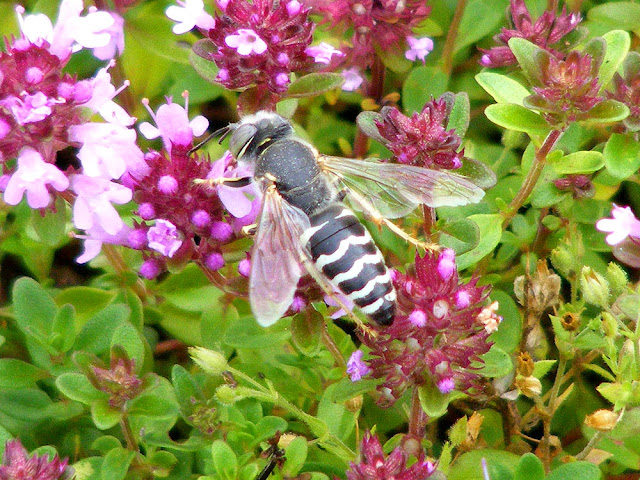Fabulous little patch of wild flower rich nature strip next to the public library in Preuilly sur Claise.
The little patch of nature strip by the library in Preuilly is a tiny treasure trove of biodiversity. It's a wild flower rich area of dry chalky soil, very attractive to bees -- and as it turns out, some rather special wasps.
Male sand wasp Bembix oculata, nectaring on wild thyme Thymus sp.
The other day I was thrilled to see quite a number of sand wasps Bembix oculata working over the wild thyme flowers. These handsome insects are about the size of regular 'yellow jacket' or Vespula type social wasps but completely different in behaviour. Although you will often see many of them together if you have them in your locale, they are in fact a solitary species. That means they don't work together to nest and raise young, but individually.
All the ones I saw near the library were male. I suspect the females are not yet around and these males have nothing better to do than to gorge themselves on nutritious wild flower nectar whilst waiting a few days until the females emerge.
When the females do emerge they will not only visit flowers, but they will hunt flies too. Their prey is used to stock nest holes in dry, usually sandy, soil, to provide their growing larvae with food. I've not witnessed this, but apparently they dig several nest holes, lay an egg in each, then very rapidly go about hunting down a variety of flies to stock the nests with, all within a few hours.
Here in the Loire Valley we are as far north as this species reaches. In France it is recorded most frequently along both the Atlantic and the Mediterranean coasts, but more rarely along a few suitable river valleys, such as the Loire, the Garonne and the Rhone. It has not been recorded north of the Loire (quite a common border line for species distribution in general).
My guess is that the species is nesting in this little patch of dry chalky soil, just like the Ivy Bees Colletes hederae are. Everything the wasps need is within a few tens of metres. For those of you who worry about such things -- these male wasps cannot sting, and I've never heard of anyone being stung by a female of this type of wasp.
This little patch is home to four species of wild orchid, wild thyme Thymus sp, Birdsfoot Trefoil Lotus corniculatus, Red Clover Trifolium pratense, Mouse-ear Hawkweed Pilosella officinarum and Dwarf Thistle Cirsium acaule.
Let's hope the municipal council learns to mow it as infrequently as possible, to preserve all this biodiversity. I was there so long photographing all the action that a man visiting the cemetery came over to see what I was doing. He was interested in insects himself and had guessed I must have seen something good, so we had a nice natter about such things.
Cliquez ici pour la version française.
Cliquez ici pour la version française.
************************************************
For details of our private guided tours of chateaux, gardens, wineries, markets and more please visit the Loire Valley Time Travel website. We would be delighted to design a tour for you.
We are also on Instagram, so check us out to see a regularly updated selection of our very best photos.
We are also on Instagram, so check us out to see a regularly updated selection of our very best photos.








7 comments:
Interesting as a few weeks ago I spotted a similar insect on our flowers, was going to take a photo but it had gone by the time I got the camera. As you say it comes no further North than the Loire it must rule it out. Any ideas on other black and white wasp/bee insects. Col
Nothing springs to mind. No Bembix species occur in mainland Britain. Melicta spp and Andrena cineraria are black and white but they are fuzzier and clearly a bee. Coelioxys spp are very much smaller.
Oh! I wonder if what you saw was one of the Scaeva spp hover flies?
Having looked at the pictures it could well have been...
Yes, I think Scaeva sp is very likely.
I may have seen this today on my blooming Vitex tree, I thought it was a frelon, I will check more carefully tomorrow.
bonnie in provence
They are nowhere near the size of a frelon/hornet -- about half the size, and more like the size of an ordinary social wasp/yellowjacket.
Post a Comment